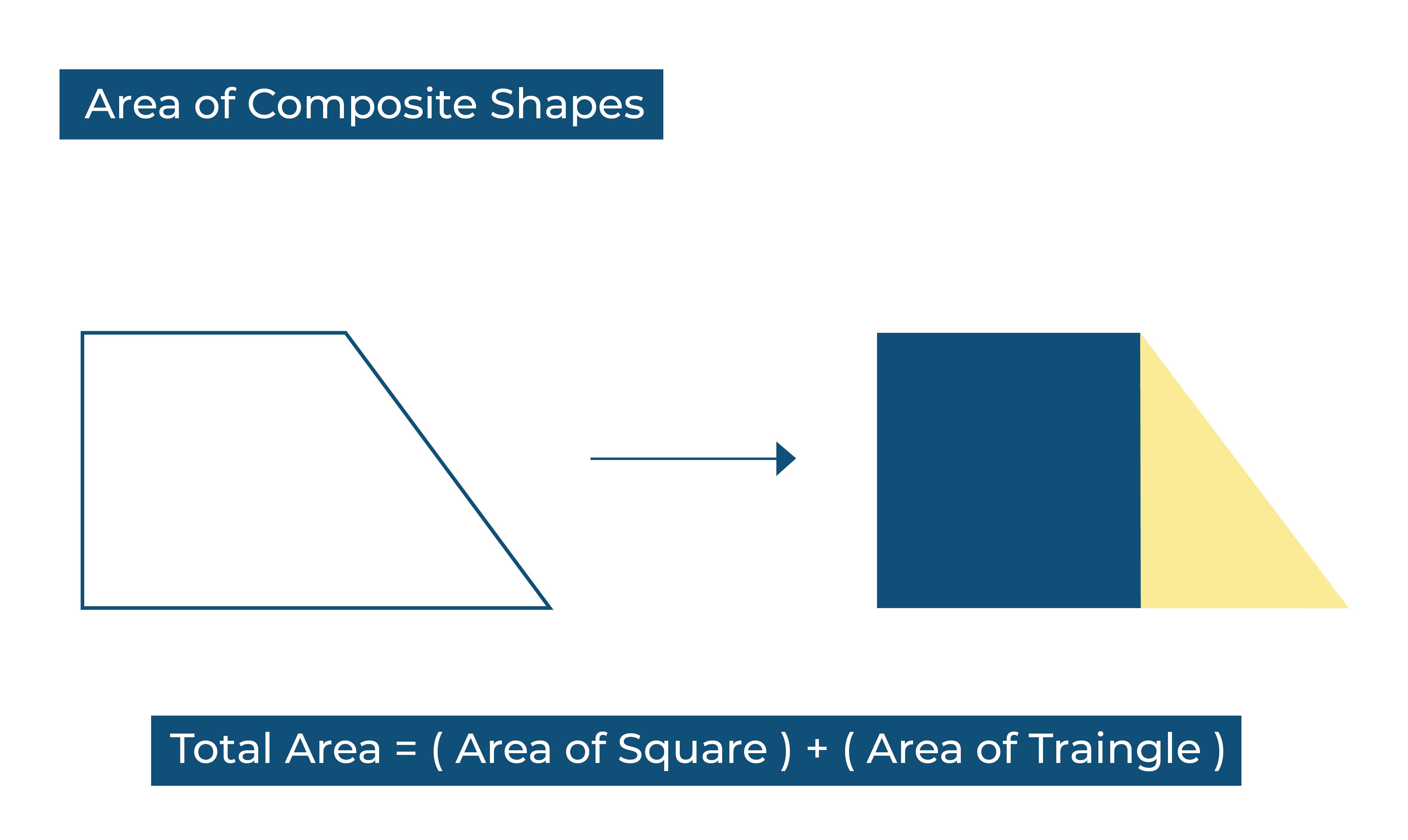Area of Composite Figures
Grade 6 Math Worksheets
Composite shapes, also known as complex shapes, are made up of two or more simple shapes. These simple shapes can be basic shapes such as squares, rectangles, circles, and triangles or other composite shapes.
In this article, you will learn:
- What is the Area of Composite Shapes?
- How to Calculate the Area of Composite Shapes?
- FAQs
Area of Composite Figures - Grade 6 Math Worksheet PDF
This is a free printable / downloadable PDF worksheet with practice problems and answers. You can also work on it online.
|
|
Untimed |
|
Sign up with your email ID to access this free worksheet.
"We really love eTutorWorld!"
"We really love etutorworld!. Anand S and Pooja are excellent math teachers and are quick to respond with requests to tutor on any math topic!" - Kieran Y (via TrustSpot.io)
"My daughter gets distracted easily"
"My daughter gets distracted very easily and Ms. Medini and other teachers were patient with her and redirected her back to the courses.
With the help of Etutorworld, my daughter has been now selected in the Gifted and Talented Program for the school district"
- Nivea Sharma (via TrustSpot.io)
Examples of composite shapes include a rectangle with a semicircle on top (a semicircular arch), a square with a triangle on top (a pitched roof), or a circle with a rectangle on top (a barrel). Composite shapes can be found in many areas of life, such as architecture, art, and design.

What is the Area of Composite Shapes?
The area of a composite shape is the total area of all the simple shapes that make up the composite shape. To find the area of a composite shape, you must first identify and separate the different simple shapes that make up the composite shape, then find the area of each simple shape individually. Once you have found the area of each individual shape, you add them together to find the total area of the composite shape.
For example, if a composite shape is made up of a square and a triangle, you would first find the area of the square by using the formula for a square, A = s^2, where s is the length of a side of the square. Then, you would find the area of the triangle using the formula for the area of a triangle, A = (1/2)bh, where b is the base and h is the height of the triangle. Finally, you add the area of the square and the area of the triangle together to find the total area of the composite shape.
Another example, if a composite shape is made up of a rectangle and a semicircle, you would first find the area of the rectangle by using the formula for a rectangle, A=l*w, where l is the length and w is the width of the rectangle. Then, you would find the area of the semicircle by using the formula for the area of a semicircle, A = (1/2)πr^2, where r is the radius of the semicircle. Finally, you add the area of the rectangle and the area of the semicircle together to find the total area of the composite shape.
“There have been times when we booked them last minute, but the teachers have been extremely well-prepared and the help desk at etutorworld is very prompt.
Our kid is doing much better with a higher score.”
6th Grade Tutoring
eTutorWorld offers Personalized Online Tutoring for Math, Science, English, and Standardised Tests.
Our Tutoring Packs start at just under $22.49 per hour, and come with a moneyback guarantee.
Schedule a FREE Trial Session, and experience quality tutoring for yourself. (No credit card required.)
How to Calculate the Area of Composite Shapes?
To calculate the area of composite shapes, follow these steps:
- Identify the different simple shapes that make up the composite shape.
- Use the appropriate formulas for the area of each simple shape to find the area of each individual shape.
- Add up the areas of all the individual shapes to find the total area of the composite shape.
For example, if a composite shape is made up of a square and a triangle, you would first find the area of the square by using the formula for a square, A = s^2, where s is the length of a side of the square. Then, you would find the area of the triangle using the formula for the area of a triangle, A = (1/2)bh, where b is the base and h is the height of the triangle. Finally, you would add the area of the square and the area of the triangle together to find the total area of the composite shape.
Another example, if a composite shape is made up of a rectangle and a semicircle, you would first find the area of the rectangle by using the formula for a rectangle, A=l*w, where l is the length and w is the width of the rectangle. Then, you would find the area of the semicircle by using the formula for the area of a semicircle, A = (1/2)πr^2, where r is the radius of the semicircle. Finally, you would add the area of the rectangle and the area of the semicircle together to find the total area of the composite shape.
It’s important to note that, when calculating the area of composite shapes, it’s best to break the shape down into smaller, simpler shapes as much as possible to make it easier to calculate the area. Also, when calculating the area of a composite shape, it’s important to be careful to use the correct formulas and measurements for each individual shape.
Do You Stack Up Against the Best?
If you have 30 minutes, try our free diagnostics test and assess your skills.
Area of Composite Figures FAQS
How do I know which method to use to find the area of a composite figure?
The method used to calculate the area of a composite figure will depend on the specific shapes that make up the figure. For example, if the figure is made up of multiple rectangles, you would add the areas of each rectangle together to find the total area. If the figure is made up of a combination of regular and irregular shapes, you may need to use different methods to find the area of each individual shape and then add them together.
How do I find the area of a shape that is made up of multiple rectangles or triangles?
To find the area of a shape made up of multiple rectangles or triangles, you would add the area of each individual rectangle or triangle together. For example, if a composite shape is made up of two rectangles with an area of 6 square units and 8 square units, the total area would be 14 square units (6+8).
How do I calculate the area of a shape that has a hole in it?
To calculate the area of a shape that has a hole in it, you would first find the area of the entire shape, and then subtract the area of the hole. For example, if a composite shape is a circle with a radius of 4 units and a smaller circle with a radius of 2 units inside of it, the area of the larger circle would be 16π square units and the smaller circle would be 4π square units, so the total area of the composite shape would be 12π square units.
How do I find the area of a shape that is made up of both regular and irregular shapes?
To find the area of a shape that is made up of both regular and irregular shapes, you would use different methods to find the area of each individual shape and then add them together. For example, if a composite shape is made up of a square with an area of 9 square units and a triangle with an area of 6 square units, the total area would be 15 square units (9+6).
How can I check if my answer is correct when calculating the area of a composite figure?
One way to check if your answer is correct when calculating the area of a composite figure is to compare it to the area of the individual shapes that make up the figure. Another way to check is to use estimation techniques like measuring the length and width of a figure with a ruler and multiplying them to get an approximate area.
Can I use the same formula for all composite shapes?
No, different composite shapes will require different formulas to find their area. The formula used will depend on the individual shapes that make up the composite figure.

Gloria Mathew writes on math topics for K-12. A trained writer and communicator, she makes math accessible and understandable to students at all levels. Her ability to explain complex math concepts with easy to understand examples helps students master math. LinkedIn
Affordable Tutoring Now Starts at Just $22.49
eTutorWorld offers affordable one-on-one live tutoring over the web for Grades K-12. We are also a leading provider of Test Prep help for Standardized Tests (SCAT, CogAT, MAP, SSAT, SAT, ACT, ISEE, and AP).
What makes eTutorWorld stand apart are: flexibility in lesson scheduling, quality of hand-picked tutors, assignment of tutors based on academic counseling and diagnostic tests of each student, and our 100% money-back guarantee.
Whether you have never tried personalized online tutoring before or are looking for better tutors and flexibility at an affordable price point, schedule a FREE TRIAL Session with us today.
*There is no purchase obligation or credit card requirement
Grade 6 Science Worksheets
- Inquiry process
- Nature of Science
- Scientific Inquiry
- Inquiry, Analysis and Problem Solving
- Ethical Practices
- Science and Society
- Biotic and Abiotic Factors
- Impact of Organisms
- Adaptation
- Spheres of Earth
- Natural Resources
- Environmental Issues
- Conservation of Earth
- Understanding Technology
- Abilities To Do Technological Design
- Structure of Earth
- Solar System
- Rocks and Fossils
- Earth Systems
- Plate Tectonics
- Evolution
- Magnetic Field of Earth
- Geologic Time
- Materials and Processes That Shape a Planet
- Astronomy
- Ecology
- Energy
- Kinetic and Potential Energy
- Energy Transfer
- Matter and its Structure
- States of Matter
- Physical and Chemical Changes
- Force and Motion
- Electricity and Magnetism
- Wave Interactions
- Sound
- Light
- Introduction to Life Science
- The Origin & History of Life On Earth
- Plant and Animal Cells
- Parts of a Cell
- The Cell Cycle
- How Living Organisms Get Energy
- Classification of Organisms
- How Plants Grow & Reproduce
- The Human Respiratory System
- The Human Cardiovascular System
- The Human Digestive System
- The Human Endocrine Systems
- The Human Nervous System
- The Human Muscular System
- The Human Skeletal System
IN THE NEWS

Our mission is to provide high quality online tutoring services, using state of the art Internet technology, to school students worldwide.
Online test prep and practice
SCAT
SSAT
ISEE
PSAT
SAT
ACT
AP Exam
Science Tutoring
Physics Tutoring
Chemistry Tutoring
Biology Tutoring
Math Tutoring
Pre-Algebra Tutoring
Algebra Tutoring
Pre Calculus Tutoring
Calculus Tutoring
Geometry Tutoring
Trigonometry Tutoring
Statistics Tutoring
Quick links
Free Worksheets
Fact sheet
Sales Partner Opportunities
Parents
Passive Fundraising
Virtual Fundraising
Our Expert Tutors
Safe and Secure Tutoring
Interactive Online Tutoring
After School Tutoring
Elementary School Tutoring
Middle School Tutoring
High School Tutoring
Home Work Help
Math Tutors New York City
Press
©2022 eTutorWorld Terms of use Privacy Policy Site by Little Red Bird
©2022 eTutorWorld
Terms of use
Privacy Policy
Site by Little Red Bird










